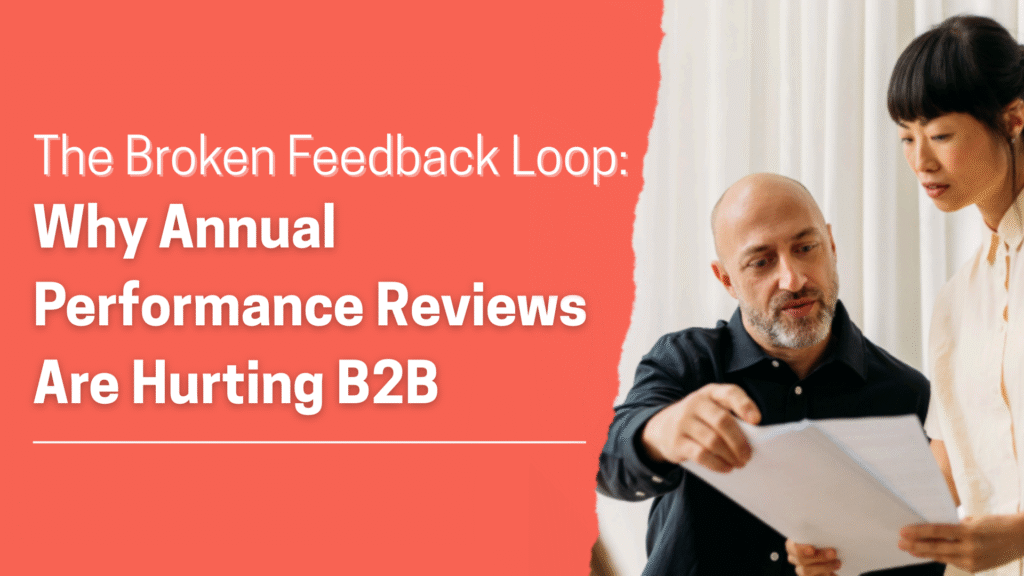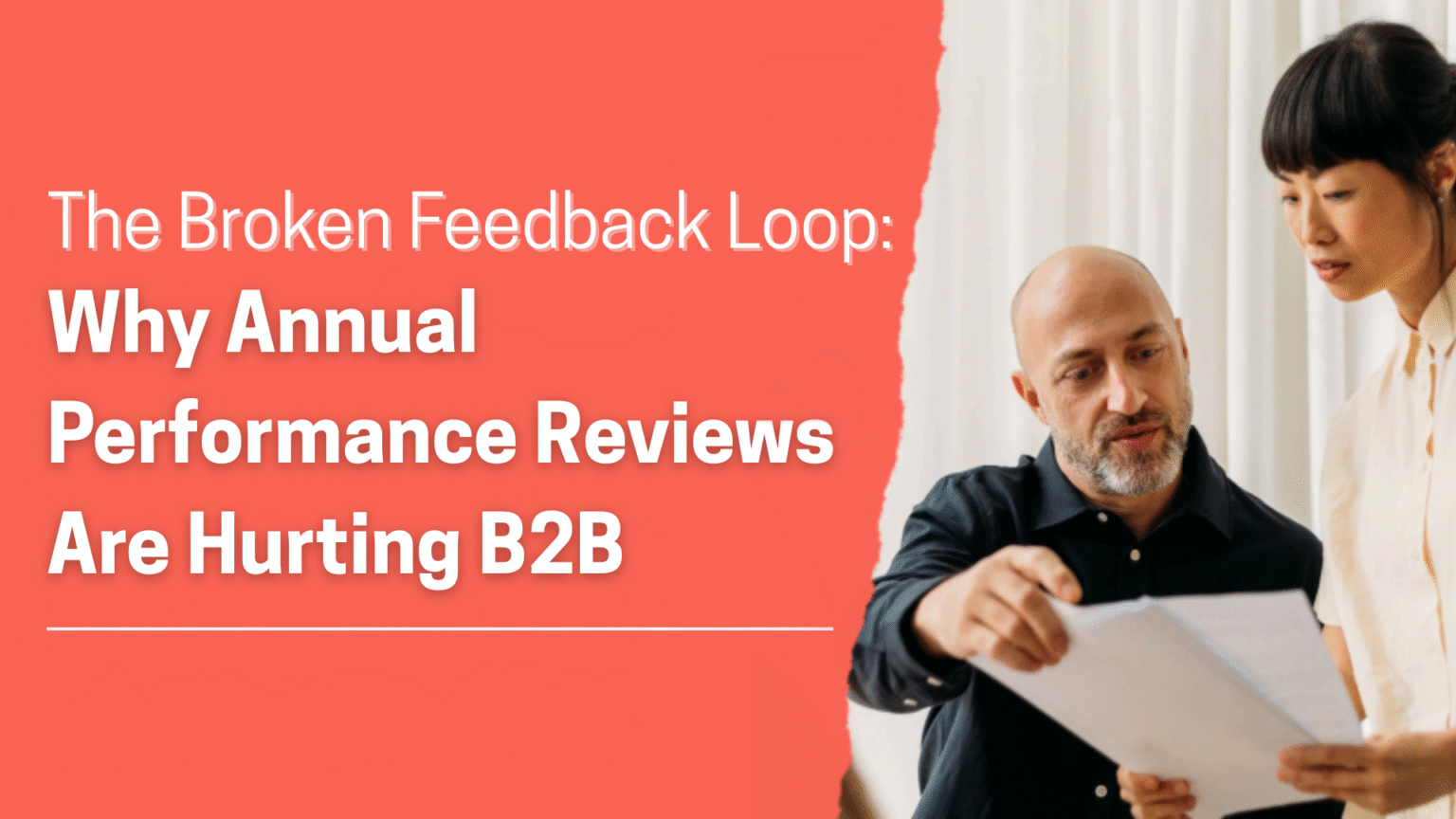
In many B2B organizations, the annual performance review is still seen as the cornerstone of employee evaluation. It’s formal, structured, and often deeply embedded in HR policy. But here’s the reality: in today’s fast-paced business environment, annual reviews are not just outdated — they’re actively damaging performance, morale, and retention.
The modern B2B workforce requires speed, adaptability, and continuous improvement. Yet the traditional performance review process is stuck in a slow, rigid cycle that no longer reflects how people work. Worse, it creates feedback bottlenecks, builds anxiety, and leads to decisions based on stale information.
The Legacy of Annual Reviews: Designed for Stability, Not Agility –
Annual performance reviews date back to an era when business environments were slower and more predictable. In manufacturing, industrial, or long-cycle sales models, once-a-year check-ins made sense. Managers reviewed set KPIs, employees received raises, and companies kept the machine running.
But that structure assumes:
- Work is linear and consistent year-round
- Goals remain static over 12 months
- One manager has full visibility into an employee’s contributions
- Feedback is best delivered retroactively
In B2B industries today — where client needs shift quarterly, remote teams span time zones, and cross-functional collaboration is the norm — this model is no longer viable.
The Human Cost: Stress, Mistrust, and Misalignment –
For many employees, annual reviews are a source of dread, not development. The high-stakes nature of a once-a-year evaluation can cause unnecessary stress, particularly when there’s been little to no feedback throughout the year. This leads to surprise criticisms, defensive behavior, and — ultimately — disengagement.
From a team dynamics perspective, outdated feedback loops create disconnects between managers and direct reports. By the time issues surface in an annual review, it’s often too late to address them constructively. People either become complacent or disengage entirely, feeling unheard or undervalued.
Negative outcomes include:
- Talent attrition due to lack of growth visibility
- Employees feeling undervalued or blindsided
- Performance issues lingering without correction
- Promotions or bonuses based on outdated metrics
- Diversity and inclusion setbacks due to biased recall
The Data Problem: One Snapshot Doesn’t Tell the Whole Story –
Annual reviews often rely on manager memory, subjective recall, and anecdotal evidence. This is especially problematic in B2B organizations where employees are part of complex, matrixed teams working across departments or geographies.
If feedback is only gathered once a year, performance evaluation becomes a distorted snapshot — not a true representation of effort or impact. Some employees shine brightly for one project and fade the rest of the year; others contribute consistently but quietly. Traditional reviews miss both.
Data challenges of annual reviews:
- Lack of input from peers or clients
- Recency bias (recent performance weighs too heavily)
- Overemphasis on easily quantifiable work
- Underrepresentation of soft skills, collaboration, or creative problem-solving
Continuous Feedback: What Modern B2B Teams Really Need –
High-performing B2B teams operate like agile systems — they iterate, adapt, and improve continuously. Performance management should do the same.
Continuous feedback models are built on regular, two-way conversations. Rather than waiting months to share insights, managers offer real-time input, recognize wins, and coach employees on challenges. This creates an open, growth-oriented culture.
It also allows feedback to be:
- Contextual (based on specific projects or client work)
- Timely (delivered when it’s most relevant)
- Actionable (giving employees a chance to improve immediately)
- Inclusive (incorporating peer, client, or self-assessments)
How to Transition from Annual Reviews to a Modern Feedback Culture –
Moving away from annual reviews doesn’t mean abandoning structure. It means replacing a broken system with something more dynamic, human, and performance-driven. The transition requires HR, leadership, and managers to align around a new vision of employee development.
Steps to build a modern feedback culture:
- Implement quarterly or monthly check-ins focused on growth, not grades
- Use tools or platforms that support continuous feedback and recognition
- Train managers to give clear, constructive, and timely feedback
- Encourage two-way communication so employees can share feedback upward
- Gather multi-source input to get a full picture of performance (peers, clients, etc.)
- Align feedback to business outcomes, not just behavior or attitude
Companies like Adobe, Deloitte, and GE have already retired annual reviews and adopted flexible performance models — with measurable improvements in engagement and retention. It’s not just a trend; it’s the new standard for competitive, forward-thinking B2B organizations.
The Manager’s Role: From Evaluator to Coach –
One of the most critical shifts in moving away from annual reviews is redefining the role of the manager. In a traditional system, managers act as judges — scoring employee performance once a year. But in a continuous feedback model, they become coaches and enablers, guiding employees toward better outcomes every day. This shift not only empowers employees to take ownership of their development but also builds stronger relationships between managers and their teams.
When managers adopt a coaching mindset, they provide regular input, ask better questions, and focus on removing barriers instead of assigning blame. In B2B settings, where work is complex and outcomes are often team-based, this approach leads to smarter execution and more resilient teams.
Embedding Feedback into the Culture, Not Just the Calendar –
Real transformation happens when feedback becomes part of the company’s daily rhythm — not just a process triggered by HR once a year. Leading B2B companies are embedding feedback into one-on-one meetings, project post-mortems, sales retrospectives, and even onboarding. By doing so, feedback shifts from being a task to being a habit — something expected, welcomed, and valued at every level.
HR can support this cultural shift by providing frameworks, tools, and training — but ultimately, it’s about creating psychological safety. When employees know that feedback isn’t a prelude to punishment but a tool for progress, they’re more likely to listen, adapt, and thrive. This cultural foundation will set the stage for scalable growth, continuous learning, and long-term employee retention in a competitive B2B environment.
Conclusion –
Annual performance reviews were built for a different era — one where change was slow, work was siloed, and managers had full control. In today’s B2B landscape, that model has become a liability.
The broken feedback loop is costing companies in lost productivity, poor morale, and rising turnover. But the good news? It’s fixable. By embracing real-time, ongoing feedback, B2B companies can unlock higher performance, better collaboration, and a culture where people actually want to grow.


